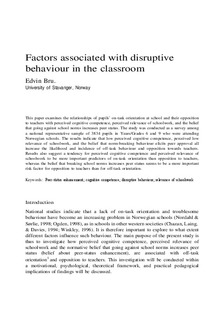| dc.contributor.author | Bru, Edvin | |
| dc.date.accessioned | 2013-07-19T10:38:20Z | |
| dc.date.available | 2013-07-19T10:38:20Z | |
| dc.date.issued | 2007 | |
| dc.identifier.citation | Bru, E. (2007) Factors Associated with Disruptive Behaviour in the Classroom. Scandinavian Journal of Educational Research, 50(1), pp. 23-43 | no_NO |
| dc.identifier.uri | http://hdl.handle.net/11250/185262 | |
| dc.description | This is an electronic version of an article published in the Scandinavian Journal of Educational Research © 2006 Scandinavian Journal of Educational Research; Scandinavian Journal of Educational Research is available online at: http://www.tandfonline.com/doi/full/10.1080/00313830500372000. | no_NO |
| dc.description.abstract | This paper examines the relationships of pupils’ on-task orientation at school and their opposition to teachers with perceived cognitive competence, perceived relevance of schoolwork, and the belief that going against school norms increases peer status. The study was conducted as a survey among a national representative sample of 3834 pupils in Years/Grades 6 and 9 who were attending Norwegian schools. The results indicate that low perceived cognitive competence, perceived low relevance of schoolwork, and the belief that norm-breaking behaviour elicits peer approval all increase the likelihood and incidence of off-task behaviour and opposition towards teachers. Results also suggest a tendency for perceived cognitive competence and perceived relevance of schoolwork to be more important predictors of on-task orientation than opposition to teachers, whereas the belief that breaking school norms increases peer status seems to be a more important risk factor for opposition to teachers than for off-task orientation. | no_NO |
| dc.language.iso | eng | no_NO |
| dc.publisher | Taylor & Francis | no_NO |
| dc.subject | peer-status | no_NO |
| dc.subject | education | no_NO |
| dc.subject | cognitive competence | no_NO |
| dc.subject | disruptive behaviour | no_NO |
| dc.subject | schoolwork | no_NO |
| dc.title | Factors associated with disruptive behaviour in the classroom | no_NO |
| dc.type | Journal article | no_NO |
| dc.type | Peer reviewed | no_NO |
| dc.subject.nsi | VDP::Social science: 200::Education: 280 | no_NO |
| dc.source.pagenumber | 23-43 | no_NO |
| dc.source.volume | 50 | no_NO |
| dc.source.journal | Scandinavian Journal of Educational Research | no_NO |
| dc.source.issue | 1 | no_NO |
| dc.identifier.doi | 10.1080/00313830500372000 | |
